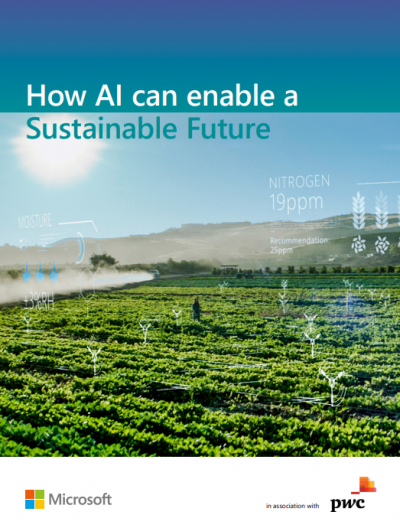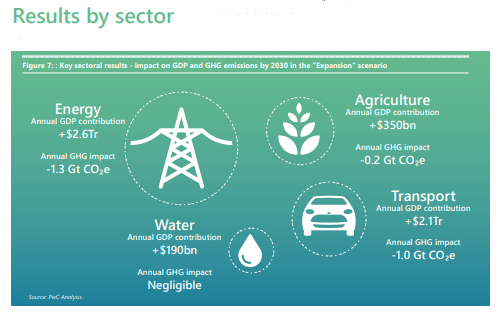New report says AI technologies can help to tackle global water crisis
- April 25, 2019
- Posted by: Elaine Coles
- Category: Environmental, Global, Technology & Innovation, Water Issues

A new report is highlighting the potential for Artificial Intelligence technologies to have a significant positive impact on the global water crisis by 2030.
Launching the joint report by Microsoft and PWc – How AI can enable a sustainable future – on what can AI do for the economy and environment, the organisations said:
“As two disruptive and powerful megatrends – digitalization and decarbonization – take hold globally, we have made a very preliminary assessment of some of the opportunities that AI can offer, for economic growth and emissions reduction potential, between now and 2030.”
The report is focused on four sectors that are critical to the economy, environment, and natural systems – agriculture, water, energy and transport. Within each sector, the analysis covers a subset of potential AI levers and looks at a business as usual growth trajectory. The study has assessed the speed and potential scale of impact, and covers GDP estimates, GHG emissions, as well as the likely impact on jobs at a global scale and across seven regions.
The report says that while AI applications in energy (up to -2.2%) and transport (up to -1.7%) have the largest impact on GHG emissions reduction of the sectors covered, water and agriculture still have an important role to play for the environment. More broadly, it also explores how AI applications can offer environmental benefits beyond GHG emissions, including impacts on water quality, biodiversity, air pollution, deforestation and land.
The analysis suggests that agricultural AI applications can help reduce emissions by up to 160Mt CO2e in 2030 whilst providing more food, and using fewer resources, pointing out:
“Moreover, the agriculture and water sectors have a vital role in preserving the health of our Earth’s natural systems, including biodiversity conservation, ocean health, freshwater quality, biogeochemical flows, forests and land system change, and related impacts on the security of food and water supply.”
Applying AI can help to ameliorate global water crisis
According to Microsoft and PWc, applying AI in water resource prediction, management and monitoring can help to ameliorate the global water crisis by reducing or eliminating waste, as well as lowering costs and lessening environmental impacts.
Analysing the impact of water AI levers on the economy and environment, the report says:
“As pollution, rapid urbanization and climate change affect the global water cycle, it is forecast that global demand for freshwater will exceed supply – falling 40% short of the quantity required to support the global economy by 2030.”
According to the authors, applying AI in water resource prediction, management and monitoring can ameliorate the global water crisis by eliminating wastage.
The key AI levers the analysis covers in the water sector are:
- Predictive maintenance of water infrastructure: real-time monitoring of infrastructure, prediction of faults and identification of management activities for optimized water systems.
- Monitoring and predicting water demand: new monitoring tools to track actual water use on an industrial and household level and allow suppliers to pre-empt water demand, reducing both wastage and shortages.
- Monitoring wastewater sources: AI is used to optimize operating conditions and can model water treatment and desalination processes, enabling reuse of greywater.
According to the report, the water sector has the potential to reap labour productivity benefits as AI technologies automate routine processes and can optimize use of specific inputs such as pipes through tools that enable real-time monitoring of water infrastructure. In addition, the sector can also reduce electricity consumption and its emissions via AI levers that predict and monitor water demand.
While AI-enabled water levers are estimated to have a small impact on global GDP and a negligible impact on global GHG emissions, they are expected to play a vital role in preserving the health of the Earth’s natural systems, such as freshwater resources, forests, oceans, etc.
However, the benefits of water savings will not be achieved solely through AI, but will also require the adoption of a wider set of complementary technologies, Microsoft and PWc suggest. As an example, while predictive maintenance can reduce water losses from leaks, it will also need sensors built into water infrastructure and connected to the IoT to feed dynamic data.
The report says:
“This presents a particular opportunity for developing regions to leapfrog their developed counterparts – with a greater proportion of infrastructure to be built over the coming decade, sensors can be included in planning and integrated from the start, at a much lower marginal cost than retrofitting existing networks.”
Even on current pathways AI adoption by 2030 will deliver substantial economic and environmental benefits
 Microsoft and PWc are predicting that even on current pathways AI adoption in the four sectors will deliver substantial economic and environmental benefits, including:
Microsoft and PWc are predicting that even on current pathways AI adoption in the four sectors will deliver substantial economic and environmental benefits, including:
- AI for the environment solutions could contribute up to $5.2 trillion USD to the global economy in 2030, a 4.4% increase relative to Business as Usual.
- Deployment of AI levers globally could in parallel reduce worldwide GHG emissions by up to 4.0% in 2030, an amount equivalent to 2.4 Gt CO2e, equivalent to the 2030 annual emissions of Australia, Canada and Japan combined.
- Create up to 38.2 million net new jobs across the global economy
“Put simply, AI can enable our future systems to be more productive for the economy and for nature. This supports the proposition that we can use AI to help ‘decouple’ economic growth from GHG emissions”, the authors say.
The organisations also point out:
“It is worth noting that this estimate is a lower bound, as the climate impacts model only attempted to take into account sea level rises, changes in agricultural productivity, and key health effects from increased temperatures.”
Other significant impacts, including economic damages due to the increasing severity and frequency of extreme events, the spread of invasive species, and the costs of significant migration between regions, have not been included in the analysis.
Traditional policy and market responses have been inadequate to date
Commenting on the “wide-ranging, serious and urgent impacts on the Earth’s systems resulting from human activity”, the report says that “traditional policy and market responses have to date been inadequate to drive the scale and urgency of the systems and sectoral transformations required.”
According to the report, the positive economic impact of environment-oriented AI applications can be achieved through three main channels
- Optimizing use of inputs as new AI tools enable more precise monitoring and control of the production process, therefore boosting output and creating opportunities for cost savings. For example, precision monitoring in agriculture can enable savings of specific inputs such as fertilizers and water used for irrigation;
- Higher output productivity as innovative technologies enable new and more efficient processes, enabling greater output to be produced for a given set of inputs.
- Automation of manual and routine tasks in given sectors can reduce errors, increase the efficiency of the workforce, and result in higher output with lower labour costs.
AI could help significantly reduce impact from extreme weather events
The report is also highlighting the potential of AI to significantly reduce the impact from extreme weather events, which are increasing in frequency and intensity due to climatic change, by enhancing natural disaster resilience from flood and storm damages.
With an estimated 250 million people already affected by flooding annually, the analysis suggests that AI-enabled improvements to forecasting could enable flood early warning systems which would save over 3,000 lives, result in 1.2m fewer people made homeless and mitigate $14m economic damages between now and 2030.
More accurate forecasting through machine learning of storm damage in forestry could help management to improve storm resilience, reducing forest wind damage, which currently accounts for around half of all forest damage in Europe, by 2 million m³ (preventing the loss of 800k tons of carbon uptake). “Similar applications, while only emerging, could also be on the horizon for drought – and earthquake – resilience,” the report says.
“Huge opportunity foregone if leaders and decision-makers do not help enable AI innovations for the environment”
Microsoft and PWc said they recognised that the research has limitations and acknowledged the difficulties of fully capturing the impacts, including accurately estimating rebound effects and evolving sectoral interactions. However, they point out:
“Even within this narrow scope, we have reason to be optimistic: AI adoption in these sectors, even on current pathways, is predicted to deliver substantial economic and environmental benefits.”
The authors conclude:
“AI applications, therefore, offer a range of positive impacts for the environment. Or to put the headline results another way, there is a huge opportunity foregone if leaders and decision-makers do not help enable AI innovations for the environment.”
Click here to download the full report How AI can enable a sustainable future
